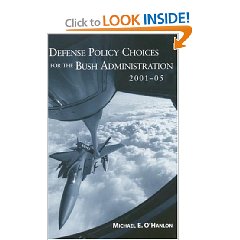Among the recommendations in this book that make it essential reading for anyone concerned with streamlining and revitalizing national security, I consider the following to be sensible:
1) cost savings should not be achieved through the wholesale abandonment of overseas commitments (13);
2) achieve additional cost savings as well as increased operational utility by sharply limiting spending on the most advanced weapons and mobility systems, applying the savings to maintaining readiness and buying larger numbers of “good enough” weaponry (83);
3) citing Stephen Rosen-he could also have cited Colin Gray-he urges a slowdown in the so-called Revolution in Military Affairs (RMA) while emphasizing that true RMA's are less about technology and more about the very best mix of people, time, and information to produce innovation (88);
4) in this vein, he noted the continued excessive focus on mobility platforms rather than C4I or joint service experimentation (90);
5) homeland defense needs several billion more dollars per year (129), a recapitalization of the U.S. Coast Guard by with at least a $750 million a year increase (135), and a sharply increased focus on setting C4I security standards for unclassified communications and computing networks across the nation, with roughly $100 million a year additional;
6) politely put, National Missile Defense is best conceptualized as theater missile defense (TMD, 143); and
7) Taiwan would be a nightmare for all sides.
Among the assertions in this book that give me pause are
1) defense down-sizing in the past ten years has been successful, trimming a third of the budget and manpower while retaining quality and cohesion (p. 1);
2) that 3% of the Gross Domestic Product is adequate for defense spending and we do not need to go to the less-than-traditional 4% (3-4);
3) that the Marine Corps should be employed to relieve Army troops in the Balkans (57) or Korea (80);
4) that North Korean armored forces would have great difficulty breaking through Allied lines to Seoul (71);
5) that rogue nations like North Korea would attempt to provide their infantry with chemical protective gear when using chemical weapons (73);
6) that US airpower is both a rapid-response solution for distant threats as well as an overwhelming response for sustained threats (76, passim);
7) that arsenal ships are survivable in off-shore loiter mode (111); and
8) that an overseas deployment rate of 8% of the total force is too high (227).
Having said that, and with all my reservations about a book, no matter how talented the author, that does not preface its discussion of force structure with a review of the recommended strategy, and a discussion of the recommended strategy with a review of the real-world right-now threat, I have to rate this book a solid four in terms of seriousness of purpose and utility of content.
It would be twice as valuable if it included a thorough discussion of what kind of Global Coverage intelligence investment is needed in order to make defense forces relevant and capable in the future; and if it included a discussion of how defense forces are but the most expensive instrument of national power, and must be designed and funded in consonance with the other instruments, and especially the severely underfunded diplomatic, economic, and cultural instruments.
The author, easily one of the top three citizen-reviewers of the national security spending program, ultimately recommends less expensive weaponry, a different two-war capability (“1+A+i”), selective reductions in overseas deployments, more defense and less nuclear offense, selective increases in homeland defense including the U.S. Coast Guard and joint experimentation, and a modest increase (roughly $25 billion) of the defense budget that would combine with his recommended savings to yield the $60 billion or so transformation delta that others have recommended.
I like and recommend this book. Out of context, however, it is a dangerous book, for it will lead an inexperienced President and a Cold War team to the conclusion that only a transformation of the traditional military (Program 50) is necessary. O'Hanlon has done it again-he has provided the baseline from within which a reasonable public debate about defense transformation might ensue. The military issues he addresses comprise both the foundation and one of the four corners of our future national security-my concern about this book is that it is completely isolated and makes no mention of the other three corners without which we cannot maintain a proper roof over our heads: intelligence (threat understanding), strategy, and Program 150 soft power-power that today is both silent and emaciated.





